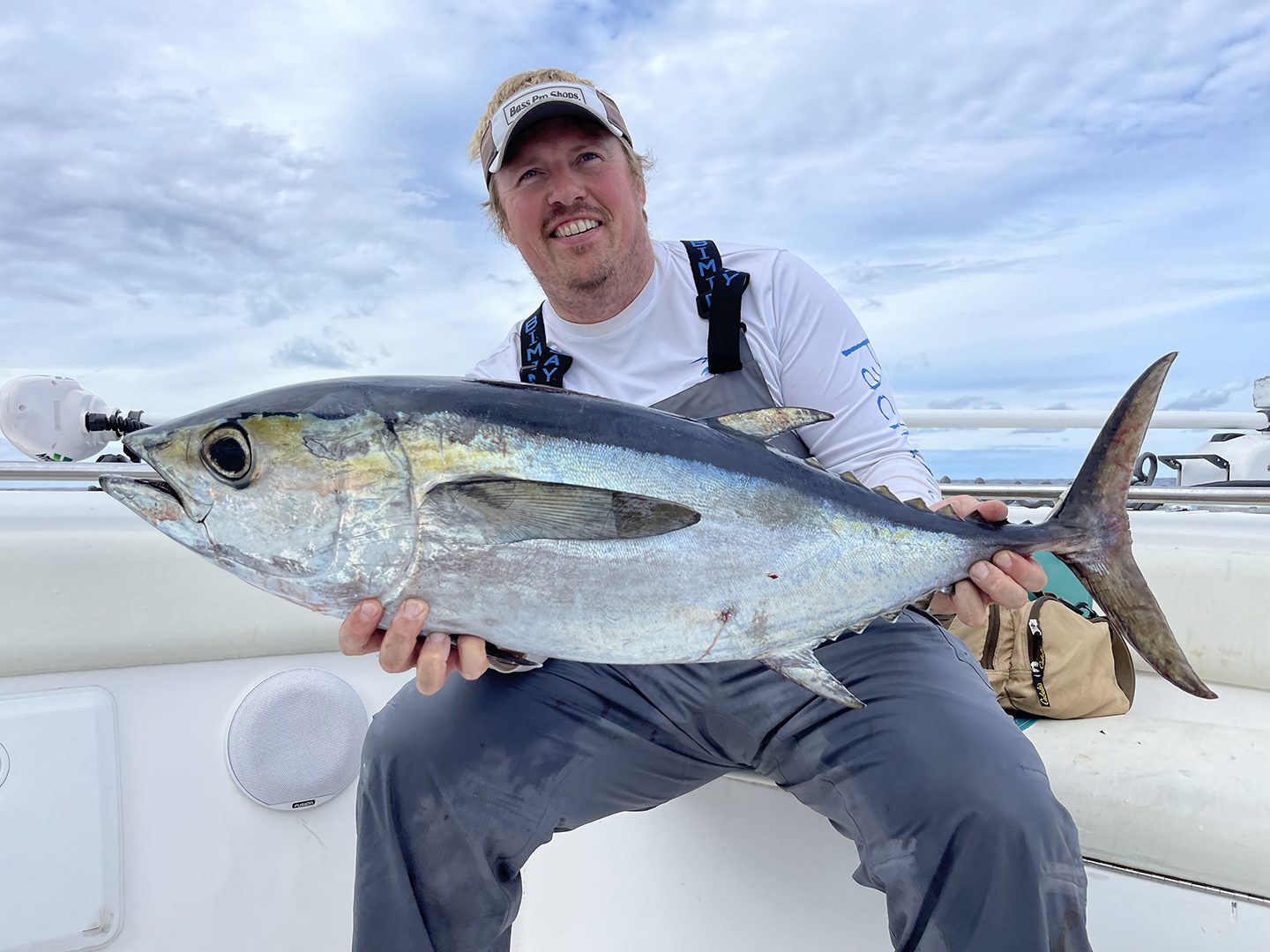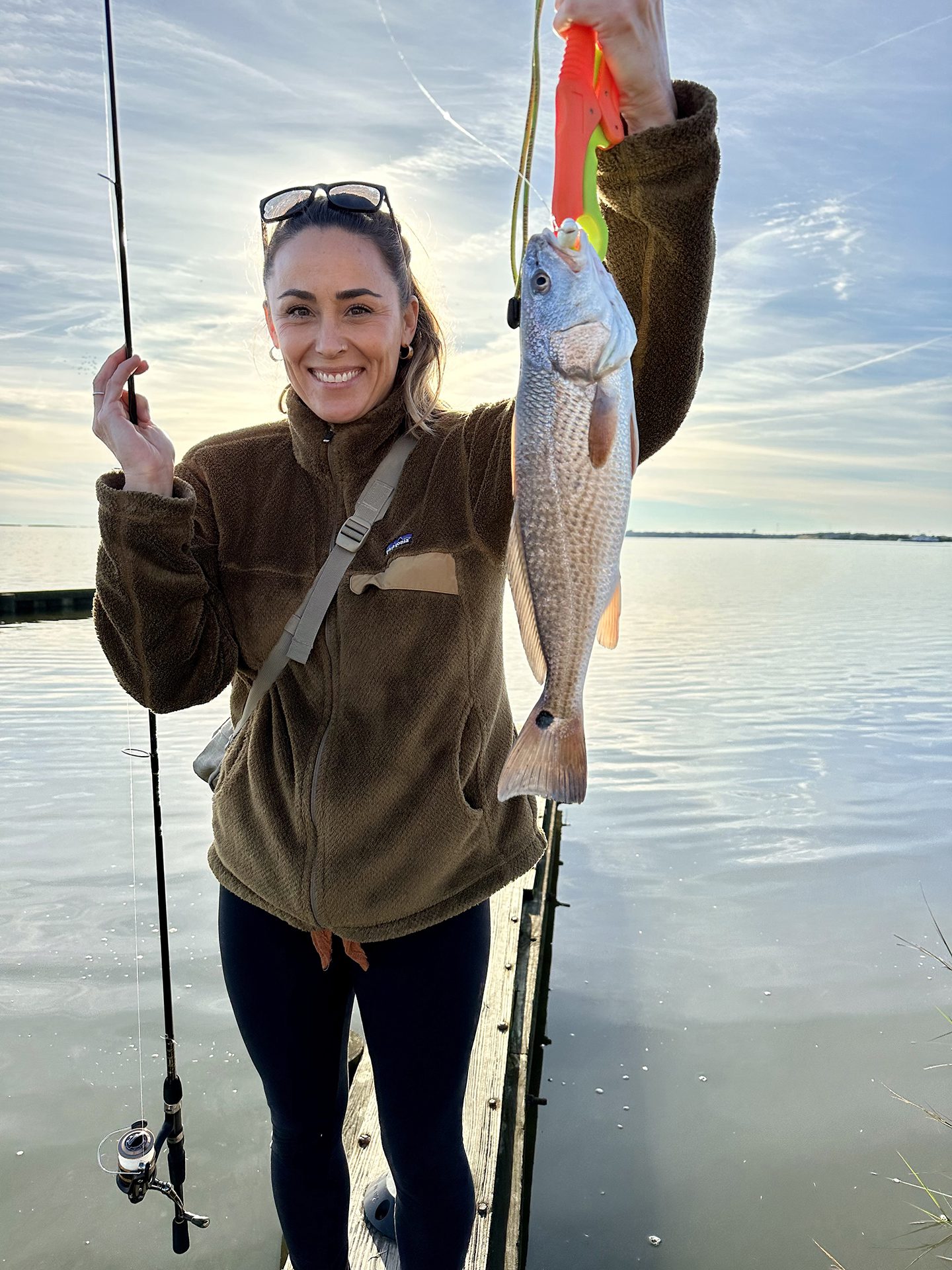Carolina Beach – March 2024
Lewis, of Island Tackle and Hardware, reports that anglers have been finding some red drum action while scouting around the bays of the lower Cape Fear River.
Speckled trout are still fairly winterized, with a few fish being caught in the yacht basin.
Surf anglers are picking away at dogfish sharks and skates. Over the coming weeks, expect to see sea mullet and pufferfish show up in better numbers when that water temperature moves up.
There isn’t much happening nearshore except the occasional tautog and smaller black sea bass on the wrecks.
Offshore runs have been hard to make with the weather conditions. March is typically another windy month, so the opportunities are usually far and between. When the window opens, efforts should produce wahoo and blackfin tuna.

Jeremiah Goldsmith, of Carolina Beach, reeled in this 21 lb. blackfin tuna 60 miles offshore using an Ilander lure rigged with a ballyhoo.
Christian, of Seahawk Inshore Fishing Charters, reports anglers have been finding a class of smaller red drum, with only a few keepers in the mix. The best bet has been to fish the low water around shell banks and grass points with nearby structure. You can also have success targeting the deeper holes that have some current.
On high tides, the best action has come from focusing on most of the standard areas: the flooded grass lines with oyster banks. Dead shrimp or scented soft plastics (such as Gulp baits) are best for fishing these cold-water conditions. The smaller the bait, the better.
Anglers fishing throughout March should focus on these same areas and use the same techniques.
Black drum could be the one addition in March, as they move into creeks around the end of the month, if not in April sometime.
Luke, of Spot On Charters, reports that moving into March, we are looking forward to sea surface temperatures moving up and that uptick getting fish more active. The speckled trout will likely stay in their same holes, but they will be more responsive to smaller soft plastics and MirrOlure Mr-17s. Water temperatures may come up, but anglers need to remember to keep retrieval speeds slow.
Red drum will continue to hold in their larger schools in the backs of bays. Soft plastics rigged with the slightest belly weight is all you need for these fish. Be sure not to spook the schools in these clear water conditions.
Tommy, of Mungo Fishing Charters, reports that as we move into early spring, anglers will be targeting black drum, red drum, and speckled trout.
Red drum can be found a couple different ways in this transition period. On calm days, target the flats with lightly weighted soft plastics. When that doesn’t line up and you’re likely faced with springtime winds, head back into the creeks and fish dead shrimp around oyster bars and deep turns in the creeks.
Black drum will be caught using this same bottom fishing method, with shrimp also being the top bait choice. Target those deep pockets near oyster bars or other hard structure.
For speckled trout, anglers are using a variety of artificial hard and soft baits that can be fished slowly. Most days, you will be finding the trout staged up in areas where they are a little off-current. They like to hold in these areas until those water temperatures move up some more.

Kelly Oakley, of Wilmington, found this red drum while fishing in the Fort Fisher area using mullet.
Mason, of Grand Slam Fishing Charters, reports that black drum fishing has been solid and only gets better with the upcoming warming temperature changes. Target the hard structures in the Cape Fear River (specifically around the spoil islands) with Carolina rigs and shrimp.
Some red drum will likely be caught with these same setups in the same locations as black drum. In addition, the red drum that are in the backs of marsh flats haven’t quite broken up yet. These schools are pretty spooky by this time in the winter, though.
Speckled trout can be caught with MirrOlures or D.O.A. shrimp in some of the deeper areas that have a bit of an eddy that keeps water moving. If you can get your hands on live shrimp, drifting them under a cork will out-fish just about anything for trout.
Rod, of OnMyWay Fishing Charters, reports that a lot of the early spring transition depends on water temperatures. Anglers looking to break that cabin fever need to keep an eye on temperatures all month long.
Black sea bass fishing will be good in all of March. Expect the jumbo-sized fish to be holding out in the 20-mile range.
Nearshore anglers also look forward to the arrival of Atlantic bonito. Look for water temperatures in that 58-61 degree sweet spot range before starting efforts at the nearshore areas such as Liberty Ship and the Boxcar reefs.
Some bonito are around now, but they are mostly being found out deep (in the 18 mile area). Sight-casting to surface-feeding schools is a favorite method, but many times the winds or fish do not cooperate. Anglers can find action by trolling to find the fish or by watching the fish finder for bait as you pass over structured bottoms. If everything is holding deep, vertical jigging can also get strikes.
Otherwise, we really need to watch for water temperatures near 70 before major changes happen.





